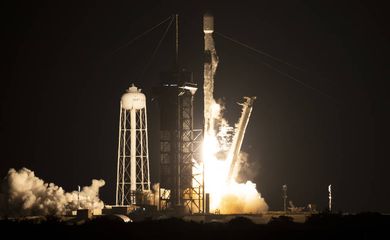NASA enters the solar corona for the first time

The space probe Parker Solar Probe, from NASA, the US space agency, flew into the Sun's upper atmosphere and captured samples of particles and magnetic fields. By touching the stuff the Sun is made of, Parker contributes to new discoveries in solar science.

"The Parker solar probe touching the Sun is a monumental moment for solar science and a truly remarkable achievement," said Thomas Zurbuchen, associate administrator of the Scientific Missions Directory at NASA headquarters in Washington.
"This milestone not only gives us deeper insights into the evolution of the Sun and its impacts on the solar system, but also everything we've learned about our own star - it teaches us more about other stars in the rest of the universe," he added.
It was during the probe's eighth approach, on April 28, that Parker first flew through the solar corona. This layer has very strong magnetic fields that dominate the movement of electrical particles. According to the scientists, it took a few months to obtain the data registered by the probe and a few more months to confirm them.
closer than ever
The closer the solar probe travels through the star's atmosphere, the more space science will make discoveries about solar flares.
One of the investigations involves analyzing the solar wind. This flow of particles from the Sun can influence the Earth and by 2019, the Parker spacecraft had already recorded that zigzag magnetic structures in the solar wind were abundant near the Sun.
However, it remains unknown how and where these magnetic fluxes were formed.
As the Sun lacks a solid surface, unlike the Earth, only by diving into the magnetically intense area can you find answers
The star has a superheated atmosphere, made of solar material that binds together by gravity and magnetic forces.
By halving the distance to the Sun, for the first time in the history of solar study, the circulation of the Parker spacecraft allowed it to be close enough to identify where the winds originate: the solar surface.
"Flying so close to the Sun, the Parker solar probe now detects details in the solar atmosphere's magnetic layer - the corona - that we never could before," said Nour Raouafi, Parker project scientist at the Johns Hopkins Applied Physics Laboratory in Laurel, Maryland.
"Because we're in the corona, we can get evidence from magnetic field data, solar wind data, and visually from images. In fact, we can see the spacecraft flying through corona structures that can be observed during a total solar eclipse." explained Raouafi.
The probe was about 13 kilometers above the surface of the Sun when it first crossed the point known as the critical surface of Alfvén, which corresponds to the transition between the solar atmosphere and the solar wind. In this area, the ship traversed in and out of the crown at least three times.
During the passage through the crown, the ship circled through structures called crown serpentines. These structures can be seen as glowing currents.
This perspective was only possible because the ship flew above and below the coils, inside the crown. Until now, the streamers had only been seen from afar. Typically, these undulating lines of light are visible from Earth during total solar eclipses.
The size of the crown also depends on solar activity. As the Sun's 11-year cycle of activity - the solar cycle - lengthens, the outer rim of the corona expands, giving the Parker Solar Probe a greater chance of staying inside the corona for longer periods of time, the scientists said.
"It's a really important region to go into because we think all kinds of physics can be activated there," said Justin Kasper, a researcher and professor at the University of Michigan. "It's very exciting that we've already achieved it. And now that we're entering this region, hopefully we'll start seeing some of these physical phenomena."
Gathering clues to luminous zigzags and other solar mysteries will allow scientists "a glimpse into a region that is critical for superheating the corona and pushing the solar wind at supersonic speeds." These corona measurements will be important "for understanding and predicting extreme weather events in space that can disrupt telecommunications and damage satellites around the Earth" argues the scientific community.
This first pass through the solar corona, which lasted just a few hours, is one of many planned missions for the Parker spacecraft, which has been investigating the star since 2018.
In January 2022, scientists hope to see the probe travel ever closer to the Sun.
Text translated using artificial intelligence.




